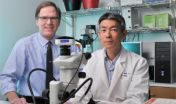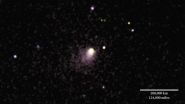(Press-News.org) Global warming is generally expected to bring spring forward but, as a new study at Ludwig-Maximilians-Universitaet (LMU) in Munich shows, a concomitant influx of plant species from warmer southern latitudes could counteract this effect.
Climate change is already clearly discernible in our part of the world. Data from local weather stations indicate that the average temperature in the Munich region has risen by 1.5°C over the past century. LMU biologist Professor Susanne Renner and her research group have now looked at the effects of this warming trend on the timing of leaf emergence ("leaf-out") in a broad range of shrubs and trees.
The inducers of leaf-out
"It is widely believed that warmer temperatures will extend the growing season and that leaf-out in our flora will occur at progressively earlier times in the year. However, whether air temperature or day-length is the dominant factor determining the date of leaf-out is actually known for very few of the thousands of species of trees and shrubs," says Renner. As Director of Munich's Botanic Garden, she was in a position to remedy this situation.
Some 16,000 plant species from diverse climate zones are cultivated in the Garden, and Renner and her doctoral student Constantin Zohner have taken advantage of this unique resource to monitor the timing of leaf-out in nearly 500 different species of woody plants. "Such a comprehensive phenological study has never been undertaken before," says Renner. Temperature and day-length are the primary triggers of leaf development, and selective forces during the course of evolution have determined which signal is actually used in a given species. The results of the new study show that, in many woody plants that thrive in warmer southern climes, day-length acts as a safety barrier so that these trees don't risk having their leaves damaged by late frosts – and increased temperature does not override this barrier.
Beech requires long days
This strategy is the better bet for thermophilic species because they are unable to cope with frost damage and are therefore susceptible to late frosts. "This evolutionary adaptation is particularly striking in the case of beech trees, in which leaf-out occurs relatively late in the year," Renner adds. "The beech in Central Europe is a relic of the warmer temperatures that prevailed during the Tertiary Period; leaf emergence requires 13 hours of daylight, regardless of whether the spring was warm or cool and moist."
"Southern species develop their first leaves up to a month later than plants from our temperate climate," says Renner, "and the more of these thermophilic species expand their range northwards as temperatures rise, the more late flushers we may gain. Moreover, species that are already adapted to our northerly climates are unlikely to undergo leaf-out at ever earlier times, because they require prior exposure to a certain number of chilly days to prime the process.
INFORMATION:
Botany: Leafing out and climate change
2014-06-20
ELSE PRESS RELEASES FROM THIS DATE:
Single tick bite can pack double pathogen punch
2014-06-20
(Millbrook, NY) People who get bitten by a blacklegged tick have a higher-than-expected chance of being exposed to more than one pathogen at the same time.
The new research, published online today in the journal PLOS ONE, was conducted by scientists at Bard College, Sarah Lawrence College, and the Cary Institute of Ecosystem Studies.
"We found that ticks are almost twice as likely to be infected with two pathogens—the bacterium that causes Lyme disease and the protozoan that causes babesiosis—than we would have expected," said Felicia Keesing, a professor of biology ...
For cancer patients, new tool predicts financial pain
2014-06-20
Cancer care has a new side effect. Along with the distress that comes with a cancer diagnosis and the discomforts of treatment, more patients now have to deal with "financial toxicity," the expense, anxiety and loss of confidence confronting those who face large, unpredictable costs, often compounded by decreased ability to work.
In the July issue of Cancer, a team of University of Chicago cancer specialists describe the first tool — 11 questions, assembled and refined from conversations with more than 150 patients with advanced cancer — to measure a patient's risk for, ...
Researcher discovers ovarian cancer treatment
2014-06-20
(Phoenix Ariz. June 19, 2014) -- Doctors at the University of Arizona Cancer Center at St. Joseph's Hospital and Medical Center in Phoenix reported today in Lancet Oncology that a new treatment for ovarian cancer can improve response rates (increase the rate of tumor shrinkage) and prolong the time until cancers recur. In addition, this breakthrough showed a trend in improving survival although these data are not yet mature.
Trebananib (formally known as AMG 386; Amgen) is a first-in-class peptide-Fc fusion protein (or peptibody) that targets angiogenesis (the growth ...
Can we see the arrow of time?
2014-06-19
Einstein's theory of relativity envisions time as a spatial dimension, like height, width, and depth. But unlike those other dimensions, time seems to permit motion in only one direction: forward. This directional asymmetry — the "arrow of time" — is something of a conundrum for theoretical physics.
But is it something we can see?
An international group of computer scientists believes that the answer is yes. At the IEEE Conference on Computer Vision and Pattern Recognition this month, they'll present a new algorithm that can, with roughly 80 percent accuracy, determine ...
New driver of atherosclerosis offers potential as therapeutic target
2014-06-19
DALLAS – June 19, 2014 – A new driver of atherosclerosis has been identified by researchers at UT Southwestern Medical Center. This molecule, known as 27HC (27-hydroxycholesterol), has been found to exacerbate the development of the condition, and may prove to be a promising therapeutic target.
Atherosclerosis is characterized by the build-up of lesions (or plaques) formed from lipids, such as cholesterol and fatty acids. Ruptured plaques can partially or completely block blood flow, potentially leading to a heart attack or stroke. A member of a larger family of molecules ...
NASA's swift satellite tallies water production of Mars-bound comet
2014-06-19
In late May, NASA's Swift satellite imaged comet Siding Spring, which will brush astonishingly close to Mars later this year. These optical and ultraviolet observations are the first to reveal how rapidly the comet is producing water and allow astronomers to better estimate its size.
"Comet Siding Spring is making its first passage through the inner solar system and is experiencing its first strong heating from the sun," said lead researcher Dennis Bodewits, an astronomer at the University of Maryland College Park (UMCP). "These observations are part of a two-year-long ...
NASA's Hubble finds dwarf galaxies formed more than their fair share of universe's stars
2014-06-19
They may be little, but they pack a big star-forming punch. New observations from NASA's Hubble Space Telescope show small galaxies, also known as dwarf galaxies, are responsible for forming a large proportion of the universe's stars.
Studying this early epoch of the universe's history is critical to fully understanding how these stars formed and how galaxies grew and evolved 3.5 to 6 billion years after the beginning of the universe. The result supports a decade-long investigation into whether there is a link between a galaxy's mass and its star-forming activity, and ...
Georgia Tech research identifies Android security weaknesses caused by performance design
2014-06-19
Georgia Tech researchers have identified a weakness in one of Android's security features and will present their work at Black Hat USA 2014, which will be held August 6-7 in Las Vegas.
The research, titled Abusing Performance Optimization Weaknesses to Bypass ASLR, identifies an Android performance feature that weakens a software protection called Address Space Layout Randomization (ASLR), leaving software components vulnerable to attacks that bypass the protection. The work is aimed at helping security practitioners identify and understand the future direction of such ...
NASA and NAU researchers welcome unexpected asteroid findings
2014-06-19
What seemed to be rock-solid assumptions about the nature of small asteroids may end in collections of rubble or even a cloud of dust, but in such findings lies the lure of the unexpected.
Northern Arizona University researchers David Trilling and Michael Mommert, while playing a well-defined role in the NASA Asteroid Initiative, are beginning to wonder if they have found a separate path of investigation.
The two researchers presented their findings about asteroid 2011 MD on Thursday during a NASA event updating progress on the path to capturing a small asteroid and ...
A new tool to confront lung cancer
2014-06-19
Only 15% of patients with squamous cell lung cancer – the second most common lung cancer – survive five years past diagnosis. Little is understood about how the deadly disease arises, preventing development of targeted therapies that could serve as a second line of defense once standard chemotherapy regimens fail.
Published online in Cell Reports on June 19, Huntsman Cancer Institute investigators report that misregulation of two genes, sox2 and lkb1, drives squamous cell lung cancer in mice. The discovery uncovers new treatment strategies, and provides a clinically relevant ...





